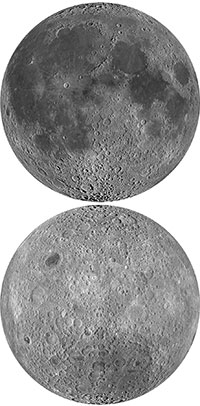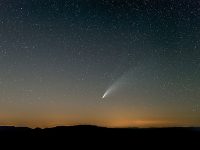
In the picture, the two sides of the Moon, the near one (above) and the far one (below), taken by the Lunar Reconnaissance Orbiter in 2009. Note the absence of dark areas (seas) on the far side. / NASA/GSFC/Arizona State University
Definitely the expression «the dark side of Moon» is not correct. It would be better to talk about a hidden or far side, since the Moon is dark in itself. The last song in Pink Floyd’s LP The Dark Side of the Moon, published in 1973, mentioned it: «There’s no dark side of the Moon really. Matter of fact, it’s all dark. » The moon shines because it reflects sunlight. Similarly to Earth, the Sun lights half the surface of the moon at all times. On Earth, we call day to that half, on the other half it is night. The same thing happens in the Moon, however, its rotational period about its axis takes much longer than one terrestrial day; it takes about a month, so every part of the moon is covered by sunlight for about two weeks, to immediately spend another two weeks in total darkness.
But, why is the Moon always showing the same side? It has to do with gravitation, which is the one responsible for making the orbital revolution of the moon around the Earth and the rotation around its axis last the same. So, as the Moon is always facing the same side towards us, we did not have images of its hidden side until in 1959 the Soviet probe Luna 3 went there, went round it and took photographs of its far side. When sent to Earth, these shocked the scientific community enormously, since they showed a very different image to that of the visible side. In the latter, the so-called maria (seas), dark and flat regions without especial roughness stand out. Light areas, on the contrary, have mountain ranges and many craters. The main feature of its far side was the lack of seas and until recently there has not been a satisfactory explanation for this fact.
Recently, a team of researchers from the Pennsylvania State University has suggested an explanation. There was already consensus within the scientific community that the Moon came to be as a result of the impact of an asteroid the size of Mars on Earth. The impact would have torn the Earth’s and the asteroid’s outer layers, which later would form the Moon. After the impact, the surface of both bodies would have been extremely hot and would cool down slowly. The Moon, being smaller, would cool sooner. The Earth, at 2,500 degrees, would radiate heat to the near side of the Moon, which, in turn, was then between ten and twenty times closer than it is now. This radiation would make the half of the moon facing the Earth to be much hotter than the other half. This temperature difference caused the surface in both sides to be different, since in the far and coldest side aluminium and calcium condensed rock vapour in the atmosphere and these minerals fell to become part of a harder and thicker Moon crust than that on the near side.
Subsequent meteorite impacts would produce different effects in both moon sides due to differences between crusts. While on the near side impacts, when piercing the crust, would produce basaltic lava releases which would eventually become the maria after cooling; on the far side, with a harder and thicker crust, impacts would produce only valleys, ridges and craters, and not the characteristic seas of the near side. Finally, some light shed on the «dark» side of the Moon.




